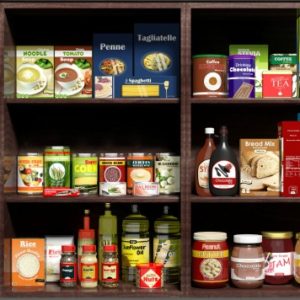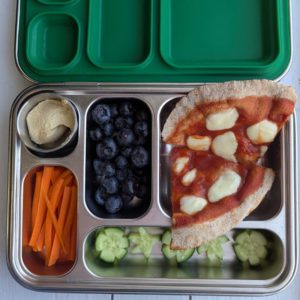
Ever feel like your pantry and refrigerator is starting to look like a black hole? Learn how to declutter your kitchen and make it feel like a new space!
Have you ever discovered an old spill that’s petrified in the back on the fridge? Some items in our cupboards, fridge and freezers have been there for so long, we don’t even see them anymore. Sight unseen, we don’t use them or worse, we forget that they’re there to the point where they’re way past their expiration date. This creates food waste, clutter, and increases your already too high grocery bill.
Let’s face it, a kitchen full of clutter and expired items is not a place anyone would want to cook in. Break this cycle by being mindful of what you already have and buying only how much you can use. You will be amazed at how a clean cupboard and fridge will inspire you to whip up something delicious in the kitchen.
Problem #1:
Buying spices when you only need them for one specific recipe (especially exotic ones such as za’atar and sumac –great in chicken kabobs), but you rarely use.
Solution #1:
Instead of committing to a full bottle, go to a specialty spice shop where you can purchase spices by weight, You can also buy the tiny brand that comes in a box with plastic pouch –just be sure to seal it tightly. This ensures that you buy only what you need.
A good idea for using up leftover spices is to create a spice blend to put on chicken, fish or popcorn. Mix up a blend of extra spices into an empty salt shaker. My daughter likes combining cayenne, cumin, chili powder and garlic powder for slaws and bean or fish tacos. Get your kids in the kitchen and have them come up with their own twist.
Problem #2:
Buying in bulk – it’s sometimes cheaper, but if you buy too many items in bulk, chances are your cupboard becomes completely full and you can’t see what you have. So what do you end up doing? Buying more of the same items instead of using up your stock. Buying at bulk at discount stores also can lead to excess weight gain. You don’t want to set your kids up for a weight struggle for life, so don’t supersize cookies, pretzels, candy or other high-calorie items.
Solution #2:
When tidying up, keep a food staple list on the fridge of what your family eats most often and only buy these items in bulk. Everything else can be bought as needed. Also, beware of sales! Buying multiple sale items of something your family doesn’t regularly eat causes clutter and can end up costing you more than you’re saving.
Problem #3:
Condensation in the fridge sometimes causes expiration dates to rub off on packages, especially bottled salad dressings, mayonnaise, or jelly.
Solution #3:
Have a permanent marker handy near your fridge. When you open a new bottle of salad dressing, mayo, salsa or sauce, make it a habit to write the expiration date in big print and where everyone in your family can see.
Problem #4:
The cupboard and fridge are disorganized because things are just stowed away as purchased, so older items are shoved to back.
Solution #4:
When stocking your fridge and pantry, place newer items behind older items. In the food service world, this is called First In, First Out (FIFO). This ensures items are consumed before their expiration date. Also, use clear containers for dry goods. This forces you to see how much you actually have, preventing you from hoarding. Have you ever felt like you’ve organized and re-organized, but your cupboards still seem cluttered? Organization guru, Marie Kondo, finds that even with a well-organized pantry, different types of colorful packaging and logos can be too “loud” and overwhelms the eyes, which our brains interpret into clutter. Clear containers help by reducing visual clutter. Don’t forget to remove the sticker logos on your clear containers as these also add to the messy look!
Another strategy is to picture your cupboards as aisles in the grocery store – organize items by category (baking, dry pasta, canned goods, etc.) and have all canned goods facing the same way. This makes items easier to locate and also reduces visual clutter.
Problem #5:
You only clean out your cupboard and fridge when they’re so full you can barely close them shut.
Solution #5:
This isn’t just a clutter issue – it’s a food safety issue. If your refrigerator is jam-packed, the cool air is unable to circulate through your goods properly. If the food isn’t properly cooled, then there is an increased chance of harmful bacterial growth. To avoid this, dedicate some time every week to cleaning your cupboard and fridge as if you’re doing the laundry. It may seem like one more task to add to your list of chores, but it saves you time in the long run. Maybe all your fridge really needs is a shelf wipe-down. Do it anyway! It saves you so much time and effort doing a quick no muss, no fuss wipe-down than using a putty scraper and tons of elbow grease for sticky messes that have accumulated over time. Get in the habit of doing a quick clean before you go grocery shopping. Better yet, add it to your kids’ chore list. Cleaning your fridge and pantry once a week also helps you visualize what you actually need to buy on your next trip to the grocery store, making you less likely to hoard items.
Problem #6:
Your recipe only calls for ¼ cup of buttermilk (or another similar item) and your grocery store only sells them in the quart containers, so the rest ends up going bad.
Solution #6:
Freezing buttermilk in ice cube tray will help it last for 3 months. Once frozen, place buttermilk cubes in a freezer bag and label with a permanent marker. This method works for homemade broths and stocks, too! Freezing is a good way to prolong the life of perishable items as the cold temperature slows and almost pauses bacterial growth. Be sure to label items with names and expiration dates. Also, it’s important to note that the texture of frozen items when thawed may be different. For example, you can freeze regular milk, but the texture won’t be good for drinking anymore. Instead, use frozen milk to add richness to soups or oatmeal.












